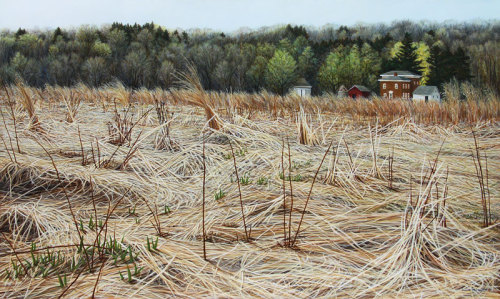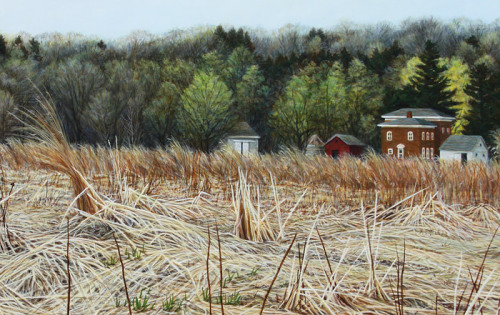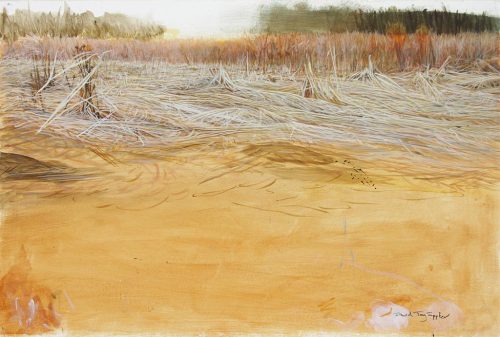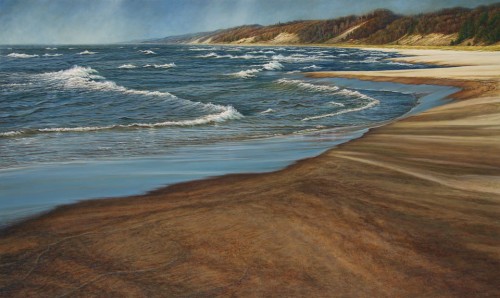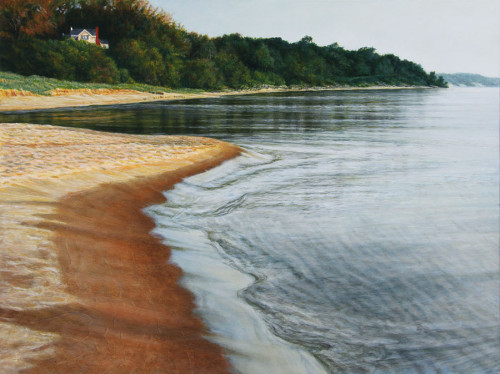Artist's Statements Artistic Motivations Exhibitions: Artist's Statement Exhibition Kalamazoo Institute of Arts Painting Philip Jamison Spring Winter
by David Jay Spyker
leave a comment
“Double Take: Artists Respond to the Collection” at the KIA
When asked if I’d like to be part of Double Take at the Kalamazoo Institute of Arts, I was more than happy to participate. A show in which I get to pick a piece from the collection and create my own work in response, and then the two would hang side-by-side? Of course I wanted to do it!
Subsequently browsing the collection on the Institute’s website, then visiting the vault to see my possible selections in person was a treat. There is some really great art in the KIA’s collection. In the end, I chose a watercolor by Philip Jamison titled “Milkweed” as my companion piece.
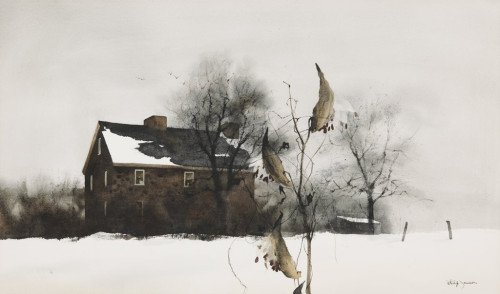
Philip Jamison, American, b. 1925
Milkweed, ca. 1950-1960
Watercolor on Paper
Collection of the Kalamazoo Institute of Arts; Gift of Mr. and Mrs. Donald S. Gilmore
Copyright Philip Jamison, image used by permission of the artist
The quiet atmosphere and solitude in Milkweed immediately made me think of a special place just a few miles from home, though I planned to paint my scene in a different season that was more personal to me.
As part of the exhibition, we were asked to write a short text speaking to the relationship of our work to our chosen piece, which would display with the paired art.
To me, Milkweed has a certain sense of quiet isolation, a solitude, which I am often looking for in my own work. When I manage to catch that mood in a scene, I feel like I’ve done something special with the painting. I can only imagine Philip Jamison must have the same sense of satisfaction when he captures a deep feeling in one of his own works.
There is a prairie tallgrass field north of Kalamazoo, and in early Spring, gentle breezes tickle last year’s dead stalks to create a quiet, pervasive whisper. If you stand for a while – with nothing but that dry rustling and the occasional bird song all around – and feel the changing vernal light and the zephyrs on your skin, you begin to get a sense of magic; it’s as if the whole world is whispering something unknown, yet deeply important.
I wrote to Mr. Jamison to tell him about the exhibition, and to ask if it would be alright to use the image of his painting for this article. What a thrill it was to read Philip’s letter in response! At 89 years of age he writes that he has been “unusually busy” lately. I hope to one day reach that age and still be busy making art.
He also writes “I have used milkweeds in many of my paintings simply because they are so prevalent in my part of Chester County…. I have vases of them in my studio…. and they have been there for over forty years”. That got me thinking of when I was a kid wandering the woods and empty fields near my house in Rochester, New York, and how each year the milkweed pods were such a source of fascination.
It was irresistible to pluck them and pry them open; I’d get the sticky milk all over my fingers, and explore how the seeds were packed inside with their silky threaded parachutes. Later in the year, when the pods would eventually split open on their own, I just had to blow handfuls of those seeds into the air.
Even today, on walks through fields, it makes me happy to see milkweed plants, and sometimes I still stop to play with the pods.
“Double Take: Artists Respond to the Collection at the KIA” is at the Kalamazoo Institute of Arts from 8/16/2014 – 1/18/2015. The show features the works of thirty area artists displayed with their corresponding selections from the KIA’s permanent collection.
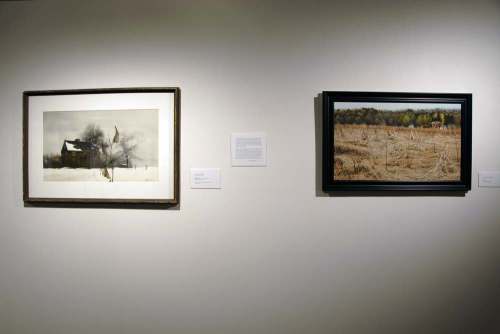
Philip Jamison’s “Milkweed” with David Jay Spyker’s “Whisper”
hanging at the Kalamazoo Institute of Arts
Photo courtesy of the KIA
Kalamazoo Institute of Arts, 314 S. Park St., Kalamazoo, MI 49007
www.kiarts.org
Artistic Motivations Exhibitions: Artist's Statement Exhibition
by David Jay Spyker
leave a comment
At the Water’s Edge
You are invited to the opening of “At the Water’s Edge” this Friday, August 15, 2014 (5:30- 7:30 pm) at the Box Factory for the Arts in St. Joseph, Michigan. This solo exhibition features 25 recent works, and runs 8/15 – 9/27.
The mood of a painting has always been very important to me. I
know I’m on the right track with a painting when I can start to feel
the subject – smell the water, taste the air, feel the temperature, hear
the wind or the waves.I have an obsession with the changing seasons and the passage of
time. The way the light changes over the year is endlessly
fascinating. Weather is the same – it’s so amazing, something full of
wonder.The season should be something you just instinctively know when
you look at the painting. If you can feel it too, then I’m on the right
track; if you’re also hearing the water or smelling the air, then I’m
really on the right track.If I’m to have an interest in it, I need to really feel my subject, and if
I don’t have an interest in it, I won’t be able to find its essence and
bring it out in the end. It’s a sort of creative circle that needs to be
complete. Ultimately, I’m after the emotional character of the
subject.
“At the Water’s Edge”, Solo Show, Box Factory for the Arts, 1101 Broad Street, St. Joseph, MI 49085
Artist's Statements Exhibitions: Artist's Statement Exhibition Shore Scene
by David Jay Spyker
leave a comment
“Eighteen Years” at the Art Center of Battle Creek
Thirty works of art spanning the years 1996 through 2014 make up “Eighteen Years”, a solo exhibition by David Jay Spyker at the Art Center of Battle Creek. You are invited to join the artist Sunday, May 4, 1-4 pm for the opening reception.
About the exhibition, the artist writes:
I think most artists are telling an autobiographical story on some level, and I would say that this exhibition, especially, does just that. By bringing together selections of my work from 1996 to 2014, and hanging them side-by-side, I hope to give a sense of where I’ve been, and where I’m going.
My art has always been rather personal, beginning with the expression of my own thoughts and ideas about the world; always toying with my own obsessions over mortality, the passage of time, and the changing seasons; then coming to include biographical moments in time.
Early influences included, among so many periods and movements, surrealism and early American landscape painting. Over the years, the surrealist influence has grown more distant, though I think it can still be felt as a quiet undercurrent in the mood of my work.
The mood of a painting has always been very important to me. I know I’m on the right track with a painting when I can start to feel the subject – smell the water, taste the air, feel the temperature, hear the wind or the waves. Going deeper than that, I’m after the emotional character of the subject.
I need to really feel my subject if I’m to have an interest in it, and if I don’t have an interest in it, I won’t be able to find its essence and bring it out in paint. It’s a sort of creative circle that needs to be complete.
If you can walk away having felt something too, then I’ll consider it a success.
– David Jay Spyker
The show runs May 4-24 at the Art Center of Battle Creek, 265 E. Emmett Street, Battle Creek, Michigan 49017.
Art Artist's Statements Artistic Motivations: Art Philosophy Artist's Statement
by David Jay Spyker
leave a comment
Artist’s Statements, Part 2
You might like to start with Part 1
I recently wrote about my initial reluctance toward having any artist’s statement for my show (Memory, Essence, Mystery). As I thought more and more about it, and began to write, the words also came more easily. I ended up with, in addition to the statement in the catalog, three other statements spaced around the exhibition room. They really helped to tie everything together, and make that personal written connection between the art and the people looking at it.
Each of the three wall cards dealt with an aspect from the show title, though they were not specifically labelled as such:
Memory
There is a relationship to personal experience in my art. What may seem like an “ordinary” landscape or shore scene actually has personal significance to me; it has memory tied to it. Sometimes, there is a reflection of that in the title of a painting. You may not know the exact connection at a glance, but it’s there.
When we interact with people, or engage with places, they become more important to us. We are woven into their fabric, and they into ours. It’s not the place that is significant, it’s what we did or felt while we were there. Each of us also has those special possessions, which mean a lot to us because of the memories surrounding them.
Personal memories and experiences are frequently expressed in my work. I’m trying to talk about them, and my thoughts and feelings that encompass them; I’m just using a visual language to do it.
Essence
There can be a lot of artistic editing that happens when I’m working out a painting based on life. I may alter colors and tones, modify some forms, or even leave out or add certain elements.
For me, there is more leeway when dealing with a landscape than, say, a portrait of a person or a bird – there you want to get the depiction of form and the inner character right.
Getting every branch on a distant tree to match what I see in the landscape isn’t so important, but finding the character of the landscape is. I may change the lighting in a scene so it works toward the emotion of the whole picture.
What matters most is that the picture express how I feel about the subject. I want the deeper character, or essence of it to come through; you should really feel something when you look at it.
Of course, some pieces are complete fabrications, and then any “rules” really fly out the window. It becomes about imagination and creating something that has the emotion I’m after, and says what I want to say.
Mystery
Like Andrew Wyeth’s quietly disturbing, highly personal images or the silent, still moment of a Vermeer, I want to capture a feeling of strange wonder that there may be something deeper and mysterious going on in a painting.
Even when it seems ordinary at first glance, I am so often trying to find something subtle – the lingering of something left unspoken or a kind of breathlessness – a stillness.
Whatever it is, if I can find that deeper emotion and work it into the picture, then I know I’ve done something right. I’m on the right track.
Art Artistic Motivations: Art Philosophy Artist's Statement
by David Jay Spyker
leave a comment
Artist’s Statements, Part 1
Let’s start by saying that as I have matured over the years, I have also become less of a fan of artist’s statements – you know, those paragraphs you see in a show catalog or hanging in the exhibition that explain who the artist is, why they do what they do, and what their work means.
Too often they read like pseudo-sophisticated bullshit that’s tailored to self-stroke the artist’s own ego, to display an intelligence and mastery of the complexities of language, or are designed to appeal to some sort of elite art world ideal.
As I considered what to say about my own most recent show (Memory, Essence, Mystery), I went through a range of emotions on the subject. I considered not even having a written statement in favor of letting the paintings and drawings simply speak for themselves, but eventually decided against it because it was still important to make that connection with the viewer about the work.
When I create art, it’s like writing in a visual language; not everyone thinks that way – a great many people think in words, and there is a communication gap there. Coming up with something to say about my work – to bridge that gap and forge a stronger connection – became important again.
It was also important to speak from the heart because that is the origin of my art; I didn’t want to intellectualize it, and risk losing that chance to speak about my work in a way that would click with people on an emotional level.
The best course for me was to write more like I might speak, to honestly transcribe the words I could hear in my mind without dressing them up in fancy clothing. This is what ended up being printed in the show catalog:
My paintings always have some kind of personal story or significance. There has to be that connection, whether it’s something coming from deep within, an inspiration tied to someone in my life, or memorable experiences that have shaped the way I feel and think about the world around me. Most often it’s all of those things. I feel very fortunate in that regard – to be able to weave those threads together in my art, and have that sort of personal connection on all those levels, because putting that down in a visible, tangible form is how I talk about life. In the end, it’s about personality, what’s in your heart, what you love – you know, that’s what makes your art great, that’s what gives it feeling. Without all of that coming through, what’s the point?
Work from the heart – write from the heart.
